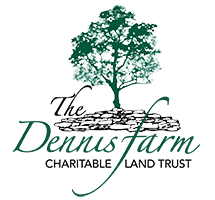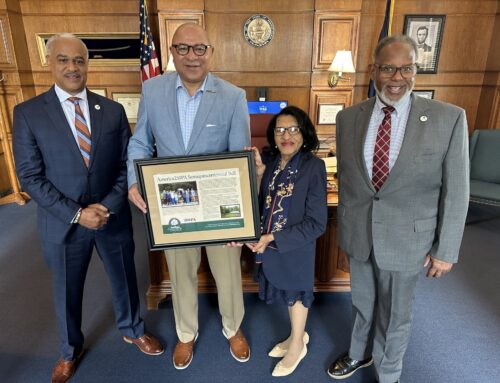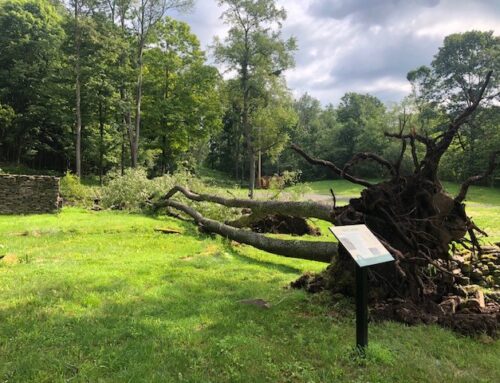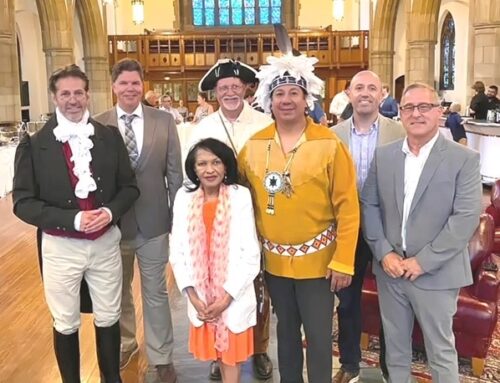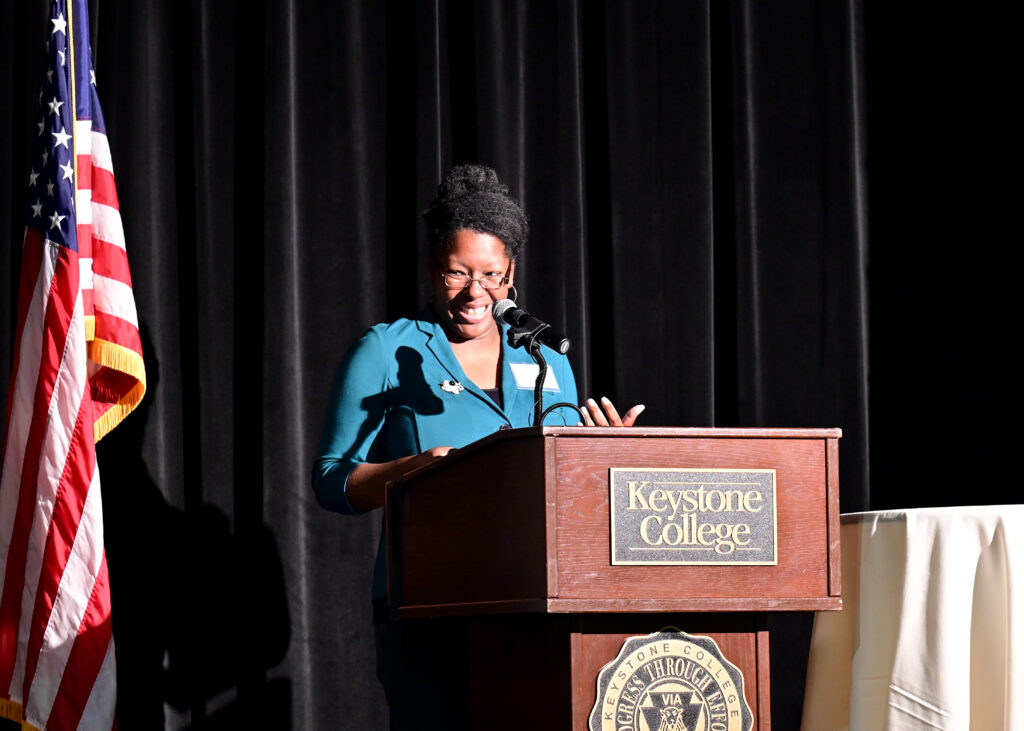
To celebrate DFCLT’s Tenth Annual Symposium, October 6, 2022, we welcomed Adrienne Whaley, Director of Education and Community Outreach for the Museum of the American Revolution, who presented a stirring keynote address. With her permission, we have reprinted the text of her slideshow presentation to share with you.
In her address, Ms. Whaley answers the question, “What is the symbolic power of the American Revolution,” and suggests that it “dares and encourages us to…use our knowledge of the past to work in the present towards a future that lives up to the best hopes and ideals of our entire founding generation.”
That generation included African Americans who, at the time of the Revolution, comprised one-fifth of the population of British North American. How, she asks, can we tell the full story, if one-fifth of it is missing? Read her keynote address below.
The Layered Onion, the Bias Grain, and the Net: Why We Explore Stories of People of African Descent in the American Revolution
Keynote Presentation
Dennis Farm Charitable Land Trust 10th Anniversary Symposium
By Adrienne G. Whaley
Director of Education and Community Engagement, Museum of the American Revolution
Thank you so much, Denise, Lonnie, Darryl, Wade, Pat and the entire Dennis Farm Charitable Land Trust team, and everyone for the opportunity to speak this afternoon. I promise you that the title of my presentation isn’t nearly as cryptic as it seems. Denise asked me to speak to the connection between the work of the Dennis Farm Charitable Land Trust and the work of the Museum of the American Revolution, and after a lot of thought about what exactly I wanted to say in my 20-30 minutes with you all, what it really boiled down to for me was: what drives us to do the work that we do. Specifically, why do we care so much about telling stories of people of African descent in the American Revolution?
And as I was stewing over a title for this talk, I reread feedback forms from a week-long summer teacher institute we held this summer at the Museum on slavery and the transatlantic slave trade in the age of the American Revolution. One of the questions we asked in the post-experience survey was “What is 1 new idea that you are playing with after this experience?” And one teacher said that she was playing with new metaphors to shape how she would teach this complicated history moving forward.
This teacher had always appreciated the idea of the “spiral” for any good curriculum to consistently review and renew content. But one speaker had now taught her to think about layering narratives about the same concept or person or place like an onion, harnessing the idea of perspective-taking to transform and radically enhance understanding. Another speaker had taught her to think about historical narrative like a piece of fabric, with weave and weft. She learned to think about reading “against the bias grain” and to pull at threads that are often unnoticed to see what’s hidden and revealed. And she was reminded through conversations with peers of the Buddhist metaphor of the net of interconnectedness. She could see so much more clearly just how interconnected the stories of the people of the Revolutionary Era were. Because of the stories we were telling about people of African descent, she was understanding American history in a new way.
But let me first tell you a little bit about who we are. How many of you have visited the museum? This is us [show picture] We’re located at 3rd and Chestnut Streets in Old City Philadelphia, across the street from the First Bank of the United States, less than a block away from Carpenter’s Hall, where the first Continental Congress met, down the street from the Pennsylvania State House, now known as Independence Hall, where both the Declaration of Independence and the Constitution were written.
Have any of you participated in our programs online, our explored our digital resources? [Engage w/ responses.] What you might know is that we talk about and engage with the Revolution a little differently than many people expect. In fact, our mission is “to uncover and share compelling stories about the diverse people and complex events that sparked America’s ongoing experiment with liberty equality and self-government.” Ours is not a story that is only about the signers of various documents, it is not only a military story; it doesn’t focus on just one class – it understands that the 2.5 million people living in British North America on the eve of the American Revolution were a diverse bunch across any number of categories, and they were part of and in conversation with a larger world. Our story includes women and children, people of different religious faiths, Native Americans of various nations, merchants, farmers, artisans, sailors, the landless and landowners, and of course, people of African descent, both free and enslaved.
And we use a bunch of methods to do that. In programs for students, families, and adults, and including offerings for people with a variety of disabilities, we offer costumed interpretation and theatrical performances, a Living History Summer Youth Institute, teacher professional development experiences, gallery guides, book talks, in-gallery talks and neighborhood walking tours, hands-on experiences with replica artifacts, primary source analysis, and more. We also offer digital interactives (both onsite and in person), like Finding Freedom, which you see on the screen.
One of the joys of our work has been being able to build a relationship with Denise and Darryl, Lonnie, Wade, Pat, and the rest of the Dennis Farm Team. For example, we have had this amazing powder horn – once owned by French and Indian War veteran and Revolutionary War soldier Gershom Prince – on display in our core exhibit since 2019, via a loan from the Luzerne County Historical Society that was generously organized by Denise. She has spoken about her family a number of times, including once as the featured guest on our virtual series Am Rev 360, in conversation with our President and CEO, and once as a speaker for our recent conference on Collecting the American Revolution.
And we have been excited to be a host for and partner with the DFCLT on their Lonae A. Moore Forum on Racial Understanding, which takes place annually in February. Put together, these create powerful opportunities to lift up stories of people of African descent in the colonial, revolutionary, and early national eras, and to draw connections between past and present.
And what’s interesting is that in telling a story that focuses on complexity and diversity – the layered onion, the bias grain, and the net – we’ve been surprising – and sometimes challenging – folks. On the one hand, that’s led to folks being excited by the number of voices included in our story. Someone called us “surprisingly woke.” And on the other, well, I’ll share this quote:
“At first the account might seem traditional…But historical scholarship has become vastly more inclusive. So we are also reminded here not just of higher principles but of how they fell short for those who were enslaved – some 400,000 in 1776 growing to nearly four million by 1860 – or for those who preceded the colonists, American Indians. Those histories – along with accounts of women’s roles – are part of this chronological narrative. This strengthens the history but weakens the event’s symbolic power.”
This latter idea is something we like to explore with teachers, because if one of the projects of the American education system has been to establish a sense of what it means to be American, the symbolic power of the Revolution is at the heart of that story. But what does it mean to be an American? And what is the symbolic power of the American Revolution? If including the story of women, Native American and people of African descent weakens the symbolic power of the Revolution, have we chosen the right story for America? Is there perhaps a different story that we can tell, one that is both challenging and optimistic? One that both dares and encourages us to be proud of our future because we use our knowledge of the past to work in the present towards a future that lives up to the best hopes and ideals of our entire founding generation? One that defines community and belonging more broadly?
I think this is why we do what we do. But it’s one of many reasons why we do what we do. Another is that it’s just good history. Remember I noted that there were about 2.5 million people in British North America on the eve of the American Revolution. Approximately 500,000 of them – or 1 out of every 5 – was a person of African descent. Imagine putting together a puzzle and calling it done when it’s still missing 1/5 of the pieces. That’s what we do when we leave the stories of people of African descent out of the story of the American Revolution. Somewhere between 5,000 and 8,000 soldiers in the Continental Army were Black, from folks who were Africa-born to people who had been in the colonies for generations. Another 15,000 actually served on the British side. And this doesn’t include the women and children camp followers who acted as nurses, laundresses, and more. Just think about the rich complexity of their stories! People of African descent served in militias, on privateers, and in the nascent Navy. Black farmers grew and Black cooks prepared food for soldiers and for gentry, brewed cider and served meals for common folk in taverns, manipulated metals and made tools as smiths of different kinds, helped print newspapers, transported goods, sewed clothing, and a host of other things. How can we understand the story of the Revolution if we leave those stories out?
We also tell these stories because they’re just plain fascinating, taking place as a part of the creation of a new political entity and the transformation of this group of people known as “Americans.” This crazy, dynamic, creative, scary, heartrending, optimistic, violent, and idealistic time has the stories to match it. And this includes stories of bravery and agency. Think about Phillis Wheatley, who is born free in Senegambia, survives the Middle Passage as a child, and becomes the first Black female poet to be published in the Western world. Her story highlights both the opportunities and challenges of this moment – from meeting gentry in London and being invited to meet George Washington by Washington himself to experiencing both enslavement and freedom in a Revolutionary moment, one that compels her to write “How well the cry for liberty, and the reverse disposition for the exercise of oppressive power over others agree–I humbly think it does not require the penetration of a philosopher to determine.”
How about Colonel Tye, who stole himself from slavery in New Jersey, travelled to Virginia, enlisted in Lord Dunmore’s Ethiopian Regiment, took command of a Black Loyalist group called the Black Brigade, and then engaged in guerilla warfare against the Revolutionaries back in New Jersey. His hope for liberty put him in direct conflict with people like free Black Lemuel Haynes, who wrote an anti-slavery tract in 1776 called “Liberty Further Extended, Or Free Thoughts on the Illegality of Slavery” that begins by quoting the Declaration of Independence, written by a slaveholder and still yet volunteered to serve in the Continental Army.
If we didn’t tell their stories, we wouldn’t get to hear about James Forten, who signed up to serve on a privateer ship – essentially a legal pirate ship, in this case blessed by the Continental Congress – when he was 14 years old. He was captured, held as a prisoner of war on a British prison ship in New York Harbor, declined two opportunities for escape – including one by the British sea captain who’d captured him, eventually became one of the wealthiest men in Philadelphia, and used his wealth and influence to demand that the city, state, and nation live up to their Revolutionary ideals.
We tell these stories because they allow people of African descent to see themselves as part of the American story, and not just on the edges, but as important actors. How many of you remember the reactions of both Black children and grown Black folks to the Black Panther previews? And what about the TikTok and Instagram reaction vides as little Black girls saw Halle Bailey as The Little Mermaid for the first time? That straight up joy at seeing people like themselves is powerful!
Now imagine what that could look like when you teach people about James Armistead Lafayette, who served as a Revolutionary spy under the Marquis de Lafayette. He was sent to the British camps and then pretended to be a spy for them while feeding them useless information and feeding the Revolutionaries useful information, ultimately helping bring about the successful Siege of Yorktown that served as the last major military conflict in the war.
What about Elizabeth Freeman, who not only defiantly acknowledged being physically abused by the woman who owned her, but left the household, went to court for her freedom and won. Her court case, alongside a group of cases involving Quok Walker, ushered in the end of slavery in Massachusetts. She built a family, purchased property, and defended her employer’s household from Shays’ Army after the war, and built such a legacy that W.E.B. DuBois literally places her in his family tree.
And we would give people the chance to know about the perseverance of Bristol Budd Sampson (a member of the Perkins-Dennis family who is buried in the cemetery on the Farm) who was so determined to get the veterans pension that he knew he deserved after serving about 6 years in the war that he made two trips from Pennsylvania to Connecticut, guided by a string that connected his hand to his son’s since Bristol was completely blind, in order to collect testimonials from his former captain in the war. (He was successful.)
Mermaids and vibranium-enhanced superheroes are great, but we also have the stories of real people that are worth getting excited about, even back in the 18th Century United States.
Finally, we tell these stories because they allow us all to see the richness and complexity of the American tapestry, right from its founding. We do a disservice to every generation when we don’t provide them with the opportunity to be better informed about the history of the land they’ve been born into – or made their own. If we don’t teach about the presence and participation of people of African descent in our nation’s founding, we keep them from understanding the foundational contributions of people of African descent, from seeing that bravery and courage know no racial or ethnic bounds, from respecting that we all have important histories. We give racism and ignorance a foothold. We hide the roots of future conflicts in our nation, the genesis of lasting impacts on generational health, educational, and economic outcomes for over one-tenth of our nation’s population, and also from examples of interracial cooperation and mutual support. Keeping this rich and complex set of stories from learners also makes it impossible for them to make well-informed decisions about our nation’s future, on things like educational policy, civic engagement, and the like.
At the Museum, we believe that one of the biggest projects of the American Revolution was working towards a more perfect future. The founding generation, those 2.5 million people, didn’t have all the answers, and – depending on who we’re talking about – had massive blind spots and dangerous hypocrisies. But they were working towards the idea of a more perfect future as a north star. We see this as the promise of the American Revolution, and our vision is that this promise endures. It cannot unless we include the stories of people of African descent – whether they supported the Revolutionary cause like the Rhode Island Regiment, James Forten, Phillis Wheatley, Prince Perkins, Bristol Budd Sampson, and Gershom Prince, or challenged it like Dunmore’s Ethiopian Regiment, the Black Pioneers, and Colonel Tye.
I want to close by sharing with you some quotes that I pulled from guests – including K-12 educators – who have experienced the Museum and its programs. I want you to see what motivates us.
We’ve got these metaphors of a layered onion with multiple perspectives, fabric with a bias grain that can be read against, and a net of interconnectedness. They’re the words of one teaching processing how to both seek out and share stories of people of African descent in the Revolutionary Era with both meaning and impact. They are also the why and the how for the work that we do in this arena. And I see them in the work that Dennis Farm does as well. I know that I am speaking to the choir, but I’ll still close by asking you all to think about them in your lives, too. How can you read against the bias grain to find the stories of people of African descent where they may be difficult to find? How can you layer them into the other stories that you tell about our nation’s past and present, like the layers of an onion? And how can you use them to remind people of our human interconnectedness, both past and present, as we work towards a future that sees us all in our full humanity?
Thank you.
